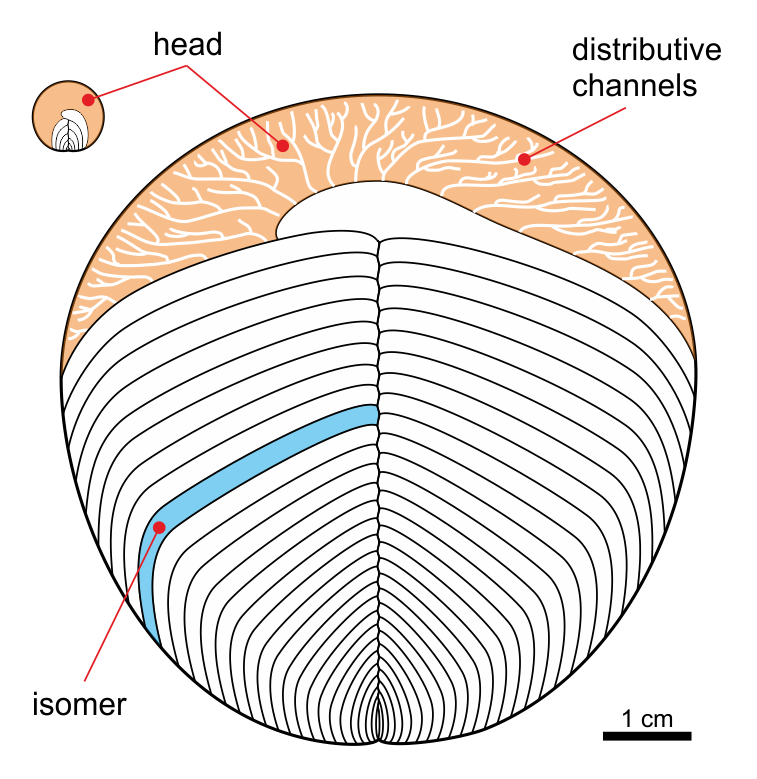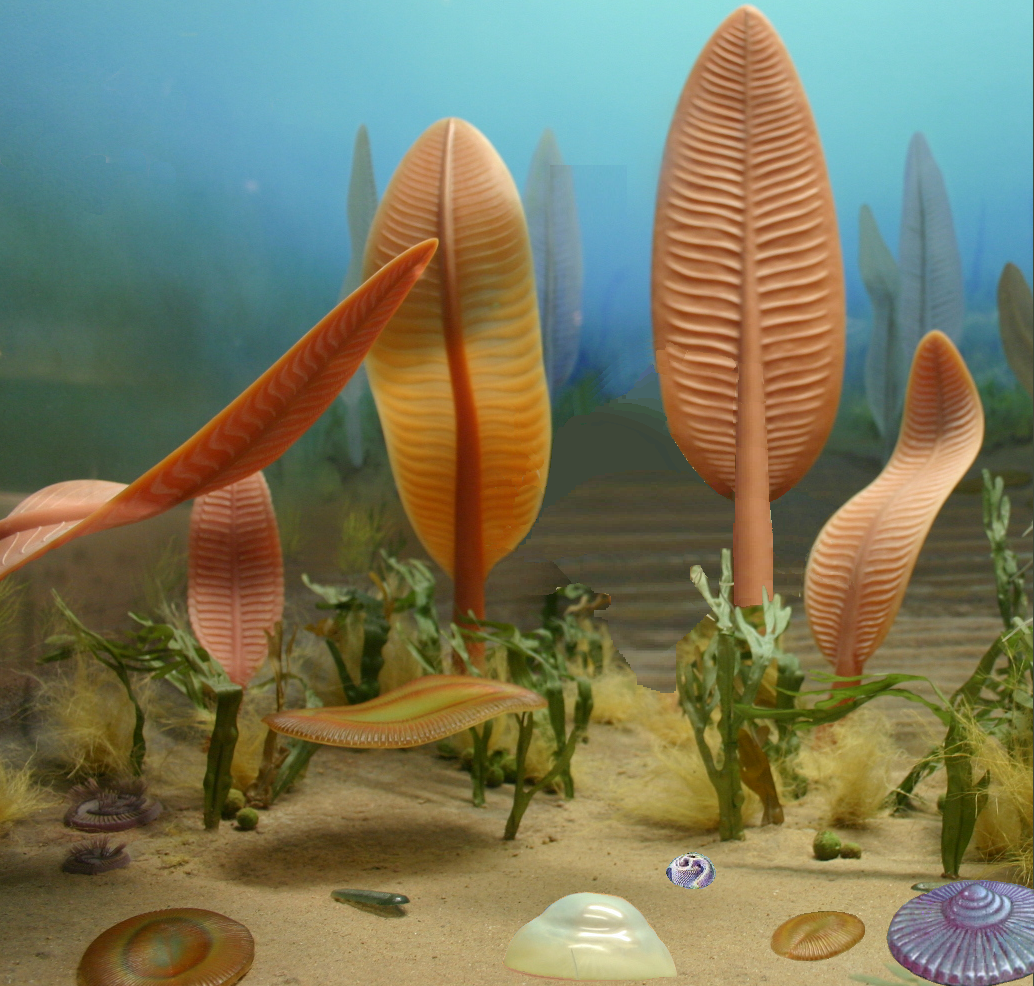|
Yorgiidae
Yorgiidae is an extinct family of the class Cephalozoa, which is a part of the wider phylum Proarticulata. They lived from around 571 to 551 Ma. Description Like other relatives within the phylum Proarticulata, their body plan consists of isomers arranged in a glide symmetry, meaning they do not have true bilateral symmetry. As with other cephalozoans, their initial right isomer extends right across the body, forming a distinctive 'head', whilst they have a unique feature with their initial left isomer extending slightly to the right side and into the initial right isomer. This is most prominent in the genus ''Archaeaspinus'', with it having an unpaired left lobe/isomer within its 'head' region, forming a distinctive question mark-like shape. Distribution Genera of the family Yorgiidae are most commonly found in the Ust' Pinega Formation and Central Urals of Russia, as well as the Flinders Ranges of South Australia. Taxonomy Yorgiidae includes the following genera: *â ... [...More Info...] [...Related Items...] OR: [Wikipedia] [Google] [Baidu] |
Cephalozoa
Cephalozoa are an extinct class (biology), class of primitive segmented marine organisms within the Phylum (biology), Phylum Proarticulata from the Ediacaran period. They possessed bilateral symmetry and were characterized by a thin, rounded body. Description Unlike the other classes of proarticulata, proarticulates, the segmentation of the body is not complete and shows a "head" with fine distribution channels. Some species of the Yorgiidae family also show some asymmetry. They were discovered in Russia near the White Sea in the Arkhangelsk region, where they lived during the Ediacaran, approximately 635 to 540 myr, Ma (millions of years ago). Taxonomy Cephalozoa includes the families Yorgiidae and Sprigginidae: Yorgiidae *†''Archaeaspinus'' Ivantsov, 2007 (synonym of ''Archaeaspis'') **†''Archaeaspinus fedonkini'' Ivantsov, 2001 *†''Yorgia'' Ivantsov, 1999 **†''Yorgia waggoneri'' Ivantsov, 1999 Sprigginidae *†''Spriggina'' Glaessner, 1958 **†''Spriggina fl ... [...More Info...] [...Related Items...] OR: [Wikipedia] [Google] [Baidu] |
Archaeaspinus Fedonkini
''Archaeaspinus fedonkini'' is an extinct proarticulatan organism from the Late Ediacaran period. Background ''Archaeaspinus'' was discovered in Zimnii Bereg, the Winter Coast of the White Sea in Russia, by A. Yu. Ivantsov in 2001. Since then, numerous additional fossils have been attributed to the genus, mostly from that same type locality, but a small number from Flinders Ranges in South Australia as well. Originally called '' Archaeaspis''—a name already applied to a redlichiid trilobite—in 2001 by Ivantsov, it was later recombined under its current name in 2007 by the same author. The type species, ''A. fedonkini'', is the only species known in this genus. It appears in the fossil record between 571-551Ma. Description As with other genera within the family Yorgiidae, ''Archaeaspinus'' is discoid. Much of its body segmented by up to 15 bilateral isomers. It has an unsegmented anterior end reminiscent of a head, full of what may be distribution channels. It also cont ... [...More Info...] [...Related Items...] OR: [Wikipedia] [Google] [Baidu] |
Archaeaspinus
''Archaeaspinus fedonkini'' is an extinct proarticulatan organism from the Late Ediacaran period. Background ''Archaeaspinus'' was discovered in Zimnii Bereg, the Winter Coast of the White Sea in Russia, by A. Yu. Ivantsov in 2001. Since then, numerous additional fossils have been attributed to the genus, mostly from that same type locality, but a small number from Flinders Ranges in South Australia South Australia (commonly abbreviated as SA) is a States and territories of Australia, state in the southern central part of Australia. With a total land area of , it is the fourth-largest of Australia's states and territories by area, which in ... as well. Originally called '' Archaeaspis''—a name already applied to a redlichiid trilobite—in 2001 by Ivantsov, it was later recombined under its current name in 2007 by the same author. The type species, ''A. fedonkini'', is the only species known in this genus. It appears in the fossil record between 571-551Ma. Descrip ... [...More Info...] [...Related Items...] OR: [Wikipedia] [Google] [Baidu] |
Proarticulata
Proarticulata is a proposed phylum of extinct, near-bilaterally symmetrical animals known from fossils found in the Ediacaran (Vendian) marine deposits, and dates to approximately . The name comes from the Greek () = "before" and Articulata, i.e. prior to animals with true segmentation such as annelids and arthropods. This phylum was established by Mikhail A. Fedonkin in 1985 for such animals as ''Dickinsonia'', '' Vendia'', '' Cephalonega'', '' Praecambridium'' and currently many other Proarticulata are described (see list). Due to their simplistic morphology, their affinities and mode of life are subject to debate. They are almost universally considered to be metazoans, and due to possessing a clear central axis have been suggested to be stem-bilaterians. In the traditional interpretation, the Proarticulatan body is divided into transverse articulation (division) into isomers as distinct from the transverse articulation segments in annelids and arthropods, as their individu ... [...More Info...] [...Related Items...] OR: [Wikipedia] [Google] [Baidu] |
Sprigginidae
Sprigginidae is an extinct family of the class Cephalozoa, characterized by having a greater number of isomers than its sister taxon, Yorgiidae. They lived approximately 635 million years ago, in the Ediacaran period. Description Like most members of Proarticulata, their body plan consists of isomers arranged in a glide symmetry, meaning they do not have true bilateral symmetry, although what sets them out from other proarticulates is their greater number of isomers, numbering up to around 40, sometimes more, overall. They also have a distinct 'horseshoe' shaped 'head'. When the first member of the family, ''Spriggina'', was discovered, it was considered to be a polychaete annelid, and petalonamid frond, and even an arthropod, with probable relations to trilobites. Although most recent studies now agree that ''Spriggina'', and the family its apart of, are apart of the phylum Proarticulata. Distribution Most genera are restricted to sediments within the Flinders Ranges of Sou ... [...More Info...] [...Related Items...] OR: [Wikipedia] [Google] [Baidu] |
Praecambridium
''Praecambridium sigillum'' is an extinct organism that superficially resembles a segmented trilobite-like arthropod. It was originally described as being a trilobite-like arthropod, though the majority of experts now place it within the Proarticulata as a close relative of the much larger ''Yorgia''. It is from the Late Ediacaran deposit of Ediacara Hills, Australia, about 555 million years ago. On average, ''P. sigillum'' had at least 5 pairs of segments, with each unit becoming progressively larger as they approach the cephalon-like head. Etymology The generic name is a compound word, with the Latin prefix ''prae'' "before" and a reference to the Cambrian mollusc genus '' Cambridium'', in reference to how the appearance of the various segments are reminiscent of the muscle-scars on the inner surface of the shells of '' Cambridium''. The specific name is from Latin ''sigillum'' "a sigil". Classification and interpretations Originally, Runnegar and M.A. Fedokin (1992) suggested ... [...More Info...] [...Related Items...] OR: [Wikipedia] [Google] [Baidu] |
Isomer (Proarticulata)
Isomer (Greek ''isos'' = "equal", ''méros'' = "part") is an element of transverse body articulation of the bilateral fossil animals of the Phylum Proarticulata from the Ediacaran (Vendian) period. This term has been proposed by Andrey Yu. Ivantsov, a Russian paleontologist from the Laboratory of the Precambrian organisms, Paleontological Institute, Russian Academy of Sciences. Morphology Proarticulatan isomers are distinct from the segments of the Annelida and Panarthropoda, as each of these elements occupies only half of width of a body and are organized in an alternating pattern relatively to the axis of the body. In other words, although proarticulatans are bilaterally symmetrical, one side is not the direct mirror image of its opposite. Opposite isomers of left and right side are located with displacement of half of its width. This phenomenon is described as the symmetry of gliding reflection.M. A. Fedonkin (1985). "Systematic Description of Vendian Metazoa". In Sokolov, ... [...More Info...] [...Related Items...] OR: [Wikipedia] [Google] [Baidu] |
Praecambridium Sigillum
''Praecambridium sigillum'' is an extinct organism that superficially resembles a segmented trilobite-like arthropod. It was originally described as being a trilobite-like arthropod, though the majority of experts now place it within the Proarticulata as a close relative of the much larger ''Yorgia''. It is from the Late Ediacaran deposit of Ediacara Hills, Australia, about 555 million years ago. On average, ''P. sigillum'' had at least 5 pairs of segments, with each unit becoming progressively larger as they approach the cephalon-like head. Etymology The generic name is a compound word, with the Latin prefix ''prae'' "before" and a reference to the Cambrian mollusc genus '' Cambridium'', in reference to how the appearance of the various segments are reminiscent of the muscle-scars on the inner surface of the shells of '' Cambridium''. The specific name is from Latin ''sigillum'' "a sigil". Classification and interpretations Originally, Runnegar and M.A. Fedokin (1992) suggested ... [...More Info...] [...Related Items...] OR: [Wikipedia] [Google] [Baidu] |
Ediacaran
The Ediacaran ( ) is a geological period of the Neoproterozoic geologic era, Era that spans 96 million years from the end of the Cryogenian Period at 635 Million years ago, Mya to the beginning of the Cambrian Period at 538.8 Mya. It is the last period of the Proterozoic geologic eon, Eon as well as the last of the so-called "Precambrian supereon", before the beginning of the subsequent Cambrian Period marks the start of the Phanerozoic Eon, where recognizable fossil evidence of life becomes common. The Ediacaran Period is named after the Ediacara Hills of South Australia, where trace fossils of a diverse community of previously unrecognized lifeforms (later named the Ediacaran biota) were first discovered by geologist Reg Sprigg in 1946. Its status as an official geological period was ratified in 2004 by the International Union of Geological Sciences (IUGS), making it the first new geological period declared in 120 years. Although the period took namesake from the Ediacara Hills ... [...More Info...] [...Related Items...] OR: [Wikipedia] [Google] [Baidu] |
Ediacaran Life
The Ediacaran (; formerly Vendian) biota is a taxonomic period classification that consists of all life forms that were present on Earth during the Ediacaran Period (). These were enigmatic tubular and frond-shaped, mostly sessile, organisms. Trace fossils of these organisms have been found worldwide, and represent the earliest known complex multicellular organisms. The term "Ediacara biota" has received criticism from some scientists due to its alleged inconsistency, arbitrary exclusion of certain fossils, and inability to be precisely defined. The Ediacaran biota may have undergone evolutionary radiation in a proposed event called the Avalon explosion, . This was after the Earth had thawed from the Cryogenian period's extensive glaciation. This biota largely disappeared with the rapid increase in biodiversity known as the Cambrian explosion. Most of the currently existing body plans of animals first appeared in the fossil record of the Cambrian rather than the Ediacaran. ... [...More Info...] [...Related Items...] OR: [Wikipedia] [Google] [Baidu] |
Andiva
''Andiva ivantsovi'' is a Vendian fossil, identified to be a bilaterian triploblastic animal in the Ediacaran phylum Proarticulata, known from the Winter Coast, White Sea, Russia. It was first discovered in 1977, and described as a new species in a new genus by Mikhail Fedonkin in 2002. It lived about 555 million years ago. Fossils of ''Andiva'' also occur in South Australia. All known fossils of ''Andiva'' are external molds. Description ''Andiva'' was between long and from wide, with a bilaterally symmetrical shape, larger on the anterior end and narrower at the posterior. The anterior part features a smooth "fringe" followed by a surface "covered by fine ribs and sutura", also described as a "quilt" with narrow, tightly packed chambers The symmetry of these ribs is a glide symmetry, that is, in which the corresponding segments on the left and right sides do not line up, but are staggered. This is a feature shared by other forms belonging to the proposed taxon Proartic ... [...More Info...] [...Related Items...] OR: [Wikipedia] [Google] [Baidu] |


